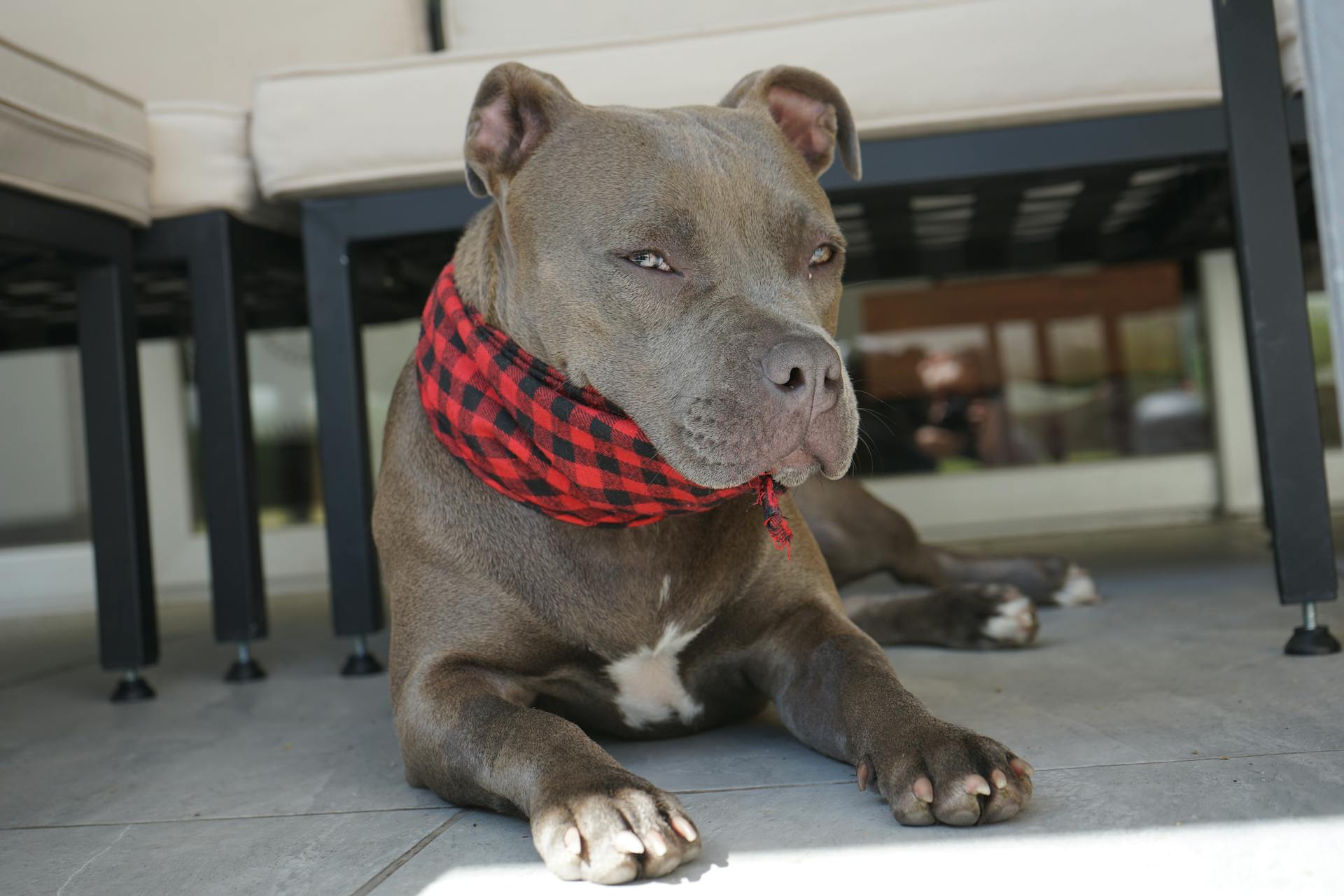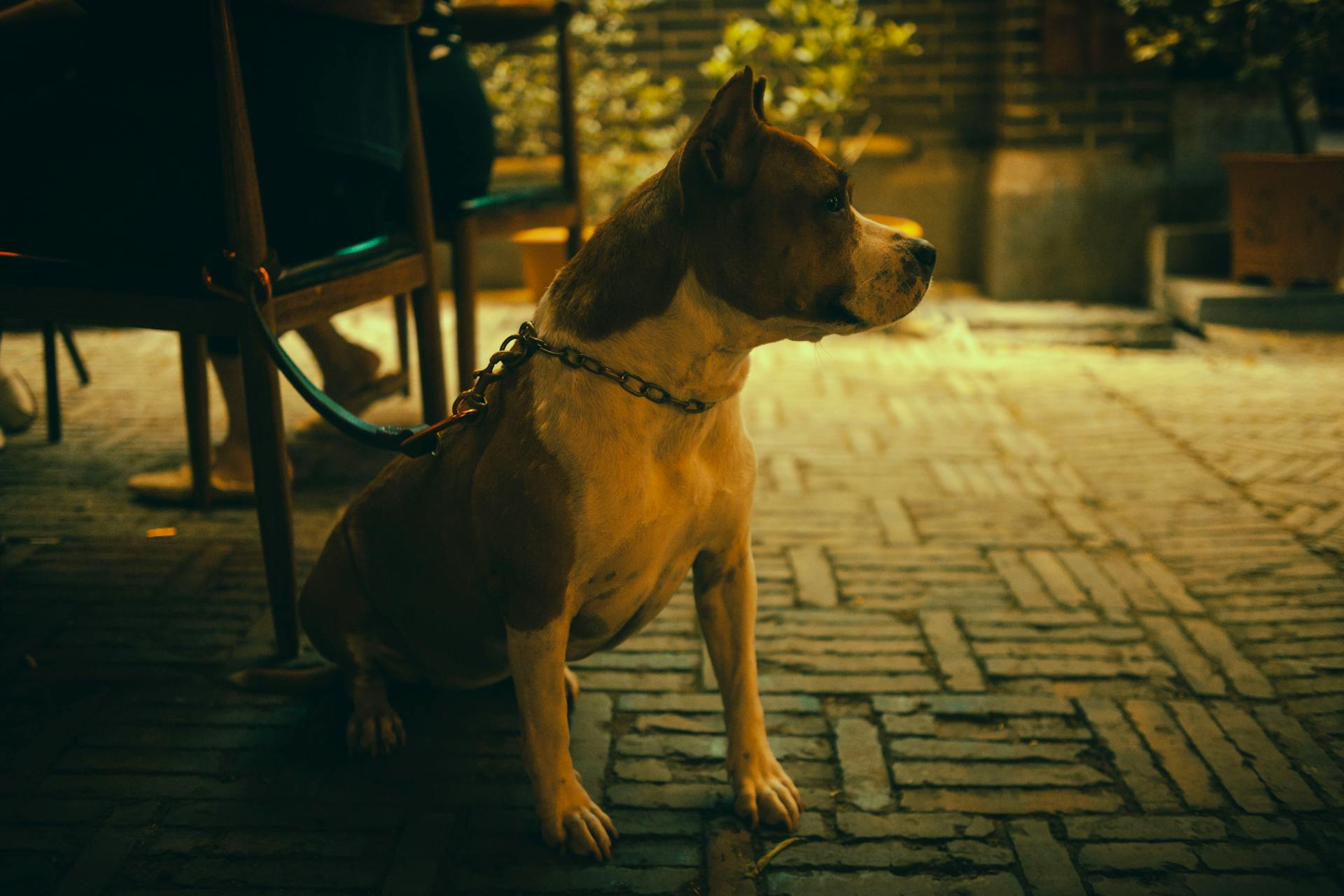
Pit Bulls are often misunderstood, and one common myth surrounding them is that their jaws lock. In reality, Pit Bulls have a unique jaw structure that allows for a "scissor-like" bite, where the upper and lower teeth interlock, but don't lock.
This myth likely originated from the breed's history as a fighting dog, where a locked jaw would have been a desirable trait. However, this is not the case. Pit Bulls have a wide, deep jaw that allows for a powerful bite, but it's not a locking mechanism.
Despite this, Pit Bulls are still capable of inflicting serious injury with their bite. According to studies, Pit Bulls have a bite force of around 235 pounds per square inch (psi), which is significantly higher than many other breeds.
Pit Bulls are also known for their athleticism and agility, which can make them a formidable opponent in a fight.
Expand your knowledge: Pit Bulls Should Not Be Banned
Do Pit Bulls' Jaws Lock?
Pit Bulls' jaws do not lock. According to Dr. I. Lehr Brisbin of the University of Georgia, no dog, regardless of breed or mix, has an anatomical structure in their jaw that functions as a locking mechanism.
Dr. Brisbin's research found no unique mechanism in American Pit Bull Terriers that would allow them to lock their jaws. There were no mechanical or morphological differences.
The media often claims that Pit Bulls have massive biting power, measuring in the thousands of pounds of pressure per square inch (PSI). However, this is not true.
Bite pressure varies wildly from article to article, making it a misleading statistic.
Pit Bull Care
Pit bulls with jaw problems may have difficulty picking up a ball due to their inability to open their mouth wide enough.
As a responsible Pit bull owner, it's essential to seek veterinary help as soon as possible to address the issue.
Pit bulls with jaw problems may require pain relief, and in some cases, steroid therapy to help switch off the inflammatory reaction and minimize scar tissue formation.
Offering soft food or a slurry can be a comfortable solution for Pit bulls having trouble eating, as it's easier for them to lap up without having to open their mouth wide.
Pit Bulls vs. Other Dogs
Pit Bulls are known for their strong jaws and tenacious nature, which can sometimes lead to a game of tug where they refuse to let go of a prize.
In fact, Pit Bulls may engage in a game of tug and decide the prize is so great they don't want to give it up, clamping down with their jaws but relying on muscular effort and determination rather than a true lock.
If you're playing tug with a Pit Bull, be aware of the signs that indicate they're determined to hold on, such as growling, guarding, shaking, hackles raised, ears back and eyes wide, tugging on the object, and shifting their weight backwards.
These signs are not unique to Pit Bulls, but they're particularly common in this breed due to their strong prey drive and competitive nature.
If this caught your attention, see: How Strong Are Pit Bulls
Training
Training is a crucial part of Pit Bull care. Consistency is key, so establish a routine that works for both you and your dog.
To begin, Pit Bulls are intelligent and thrive on mental stimulation, which means they need regular exercise and playtime. This can be as simple as a daily walk or play session in the yard.
Positive reinforcement training methods are highly effective with Pit Bulls, as they are highly food-motivated. Reward your dog with treats and praise for good behavior.
Socialization is also essential, as Pit Bulls can be wary of strangers if not properly socialized. Introduce your dog to new people, places, and experiences regularly.
Housebreaking requires patience, but with a consistent routine and plenty of positive reinforcement, your Pit Bull can learn to do its business outside.
Discover more: American Bull Dog Pit
Health
Pit Bulls are prone to certain health issues, so it's essential to be aware of them. They can be prone to hip dysplasia, a genetic condition that affects the hip joint.
Their short, easy-to-maintain coats require minimal grooming. Regular nail trimming is necessary to prevent overgrowth.
Pit Bulls are generally a healthy breed, but they can be susceptible to skin allergies and infections. These can be caused by environmental factors, food sensitivities, or genetic predispositions.
Regular dental care is crucial to prevent tartar buildup and promote healthy teeth and gums. Pit Bulls are prone to dental issues if not properly cared for.
Their athletic build requires regular exercise to maintain a healthy weight and prevent obesity. A daily walk and playtime are essential for their physical and mental well-being.
Origins
Dogs like bully breeds were bred to have powerful biting jaws that could hang onto prey, giving them a fearsome reputation.
This powerful bite is not just due to their anatomy but also to their state of mind, where they're determined to hang on at all costs.
The appearance of a locking jaw is actually an illusion, as it's all in the dog's mind rather than their jaw.
What are Pit Bulls?
Pit Bulls are a type of dog breed that originated in England in the 19th century.
The name "Pit Bull" comes from their history of being used in bloodsports like bull-baiting and dog-fighting.
Pit Bulls were bred to be strong, agile, and confident dogs.
They were often used as companions and working dogs on farms and estates.
Pit Bulls are known for their distinctive physical characteristics, including their muscular build and short, smooth coats.
Their friendly and outgoing personalities made them a popular choice as family pets.
Despite their reputation, Pit Bulls are not naturally aggressive dogs.
In fact, they are often described as gentle and affectionate with their families.
Pit Bulls have been used as therapy dogs, search and rescue dogs, and service dogs due to their intelligence and loyalty.
Curious to learn more? Check out: Female Pit Bull Terrier
History of Pit Bulls
The Pit Bull breed has a rich history dating back to the 19th century.
It's believed that Pit Bulls were first bred in England in the 1800s as a result of crossing the Old English Bulldog with the Old English Terrier.
The Bull and Terrier, a precursor to the modern Pit Bull, was a popular breed in England and Ireland for bloodsports like bull-baiting and dog-fighting.
This bloodlust was eventually outlawed, leading to the breed's decline.
The American Pit Bull Terrier was developed in the United States in the late 19th and early 20th centuries.
It's a direct descendant of the Old English Bulldog and Terrier.
Pit Bulls were initially bred for their strength, agility, and tenacity, making them a popular choice for farm work and family companionship.
They quickly gained popularity as a beloved family pet.
Their popularity soared in the early 20th century, with Pit Bulls becoming a staple in many American households.
However, their reputation would soon take a turn for the worse.
The breed's negative reputation began to take hold in the 1980s, following a series of high-profile attacks.
This led to widespread media coverage and a public perception shift.
Intriguing read: Pit Terrier vs Pitbull
Where Did Pit Bulls Originate?
Pit Bulls originated from England in the 19th century as a result of crossing the Old English Bulldog with the Old English Terrier.
In the 19th century, breeders in England wanted to create a dog that could both bait bulls and hunt small game, so they crossed the Old English Bulldog with the Old English Terrier.
Pit Bulls were originally bred to be a versatile working dog, capable of performing a variety of tasks.
Their short coats and muscular builds made them well-suited for the harsh English climate and the physical demands of their work.
In England, Pit Bulls were used for bull-baiting, a gruesome blood sport that involved setting a dog on a tethered bull.
Their popularity as a working dog and companion animal spread to the United States in the late 19th century.
In the late 19th century, breeders in the United States began to develop the Pit Bull into the distinct breeds we know today, including the American Pit Bull Terrier and the American Staffordshire Terrier.
Check this out: Pitbull Dog Brindle
History of Pit Bull Breeding
The Pit Bull breed has a rich history that dates back to the 19th century.
The first Pit Bulls were bred in England in the 1860s as a cross between the Old English Bulldog and the Old English Terrier.
Their original purpose was to participate in bloodsports like bull-baiting and dog-fighting.
Pit Bulls were also known as "Nanny Dogs" due to their gentle nature around children.
The breed gained popularity in the United States in the late 1800s.
Pit Bulls were often depicted in media as loyal and loving companions.
The first American Pit Bull Terrier was recognized as a distinct breed in 1898.
The breed's popularity continued to grow until the early 20th century.
Here's an interesting read: What Breed of Pit Bulls Is the Biggest
Frequently Asked Questions
How do I stop my pitbull from locking?
Pitbulls don't "lock" their jaws, they simply bite; teach your puppy to release objects with commands like "Drop!" or "Out!". Proper training can help prevent unwanted biting and strengthen your bond with your pet.
Sources
- https://wagwalking.com/sense/can-dogs-jaws-lock
- https://www.dogster.com/lifestyle/does-a-pitbull-lock-its-jaws-when-it-bites
- https://www.animalfarmfoundation.org/no-pit-bull-dogs-dont-lock-their-jaws-and-other-myth-busting-facts/
- https://www.dogster.com/dog-breeds/pit-bull-bite-force
- https://www.animalfarmfoundation.org/myth-busted-pit-bulls-dont-bite-differently/
Featured Images: pexels.com


